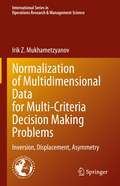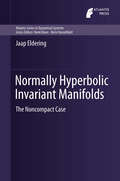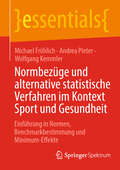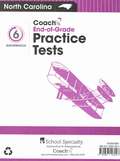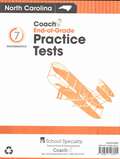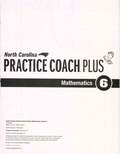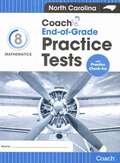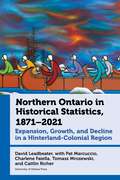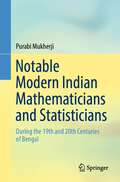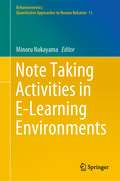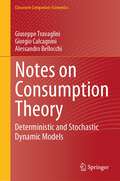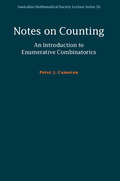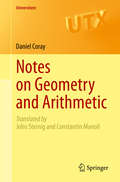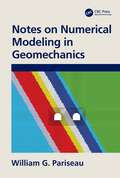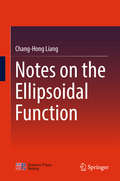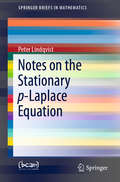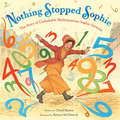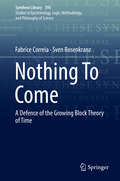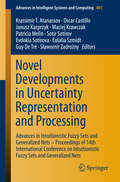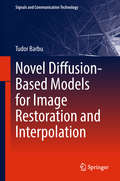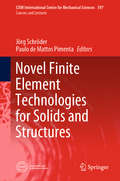- Table View
- List View
Normalization of Multidimensional Data for Multi-Criteria Decision Making Problems: Inversion, Displacement, Asymmetry (International Series in Operations Research & Management Science #348)
by Irik Z. MukhametzyanovThis book presents a systematic review of multidimensional normalization methods and addresses problems frequently encountered when using various methods and ways to eliminate them. The invariant properties of the linear normalization methods presented here can be used to eliminate simple problems and avoid obvious errors when choosing a normalization method. The book introduces valuable, novel techniques for the multistep normalization of multidimensional data. One of these methods involves inverting the normalized values of cost attributes into profit attributes based on the reverse sorting algorithm (ReS algorithm). Another approach presented is the IZ method, which addresses the issue of shift in normalized attribute values. Additionally, a new method for normalizing the decision matrix is proposed, called the MS method, which ensures the equalization of average values and variances of attributes. Featuring numerous illustrative examples throughout, the book helps readers to understand what difficulties can arise in multidimensional normalization, what to expect from such problems, and how to solve them. It is intended for academics and professionals in various areas of data science, computing in mathematics, and statistics, as well as decision-making and operations.
Normally Hyperbolic Invariant Manifolds: The Noncompact Case
by Jaap ElderingThis monograph treats normally hyperbolic invariant manifolds, with a focus on noncompactness. These objects generalize hyperbolic fixed points and are ubiquitous in dynamical systems. First, normally hyperbolic invariant manifolds and their relation to hyperbolic fixed points and center manifolds, as well as, overviews of history and methods of proofs are presented. Furthermore, issues (such as uniformity and bounded geometry) arising due to noncompactness are discussed in great detail with examples. The main new result shown is a proof of persistence for noncompact normally hyperbolic invariant manifolds in Riemannian manifolds of bounded geometry. This extends well-known results by Fenichel and Hirsch, Pugh and Shub, and is complementary to noncompactness results in Banach spaces by Bates, Lu and Zeng. Along the way, some new results in bounded geometry are obtained and a framework is developed to analyze ODEs in a differential geometric context. Finally, the main result is extended to time and parameter dependent systems and overflowing invariant manifolds.
Normbezüge und alternative statistische Verfahren im Kontext Sport und Gesundheit: Einführung in Normen, Benchmarkbestimmung und Minimum-Effekte (essentials)
by Michael Fröhlich Andrea Pieter Wolfgang KemmlerIm Sport und im Gesundheitswesen sind Normen, Normwerte und Normwertbezüge wesentlich, wenn es darum geht, Informationen zu sportlichen, physiologischen, psychologischen und/oder gesundheitlichen Kenngrößen qualitativ und quantitativ einzuschätzen. Einfache und etablierte Verfahren und Methoden zu deskriptiven, graphischen und numerischen Normwertdarstellungen sowie zu alternativen statistischen Verfahren der Normwerteinschätzung werden erläutert.
North Carolina Coach End-of-Grade Practice Tests, Mathematics, Grade 6
by Inc. School SpecialtyNorth Carolina Coach End-of-Grade Practice Tests, Mathematics, Grade 6
North Carolina Practice Coach PLUS, Mathematics, Grade 7
by North Carolina Practice CoachNorth Carolina Practice Coach PLUS, Mathematics, Grade 7 content includes: Domain 1 The Number System, North Carolina Standard Course of Study, Domain 2 Ratios and Proportional Relationships, Domain 3 Expressions and Equations, Domain 4 Geometry, Domain 5 Statistics and Probability, Glossary.
North Carolina Practice Coach PLUS, Mathematics, Grade 8
by North Carolina Practice CoachNorth Carolina Practice Coach PLUS, Mathematics, Grade 8 content includes: Domain 1 The Number System, North Carolina Standard Course of Study, Domain 2 Expressions and Equations, Domain 3 Functions, Domain 4 Geometry, Domain 5 Statistics and Probability, Glossary
North Carolina Practice Coach Plus Grade 7 Practice Tests
by School Specialty IncNORTH CAROLINA PRACTICE COACH PLUS MATH GRADE 7 PRACTICE TESTS with Practice Check-Ins
North Carolina Practice Coach Plus Math Grade 6
by Triumph Learning LlcNORTH CAROLINA PRACTICE COACH PLUS, MATHEMATICS, GRADE 6
North Carolina Practice Coach Plus Math Grade 8 Practice Tests
by Inc. School SpecialtyNORTH CAROLINA PRACTICE COACH PLUS MATH GRADE 8 PRACTICE TESTS with Practice Check-Ins
Northern Ontario in Historical Statistics, 1871–2021: Expansion, Growth, and Decline in a Hinterland-Colonial Region (Canadian Studies #10)
by Professor David LeadbeaterBased on original historical tables, Northern Ontario in Historical Statistics, 1871–2021 offers an overview of major long-term population, social composition, employment, and urban concentration trends over 150 years in the region now called “Northern Ontario” (or “Nord de l’Ontario”). David Leadbeater and his collaborators compare Northern Ontario relative to Southern Ontario, as well as detail changes at the district and local levels. They also examine the employment population rate, unemployment, economic dependency, and income distribution, particularly over recent decades of decline since the 1970s.Although deeply experienced by Indigenous peoples, the settler-colonial structure of Northern Ontario’s development plays little explicit analytical role in official government discussions and policy.Northern Ontario in Historical Statistics, 1871–2021, therefore, aims to provide context for the long-standing hinterland colonial question: How do ownership, control, and use of the land and its resources benefit the people who live there?Leadbeater and his collaborators pay special attention to foundational conditions in Northern Ontario’s hinterland-colonial development including Indigenous relative to settler populations, treaty and reserve areas, and provincially controlled “unorganized territories.” Colonial biases in Canadian censuses are discussed critically as a contribution towards decolonizing changes in official statistics.
Not So Weird After All: The Changing Relationship Between Status and Fertility (Evolutionary Analysis in the Social Sciences)
by Rosemary L. Hopcroft Martin Fieder Susanne HuberThis is the first book to fully examine, from an evolutionary point of view, the association of social status and fertility in human societies before, during, and after the demographic transition. In most nonhuman social species, social status or relative rank in a social group is positively associated with the number of offspring, with high-status individuals typically having more offspring than low-status individuals. However, humans appear to be different. As societies have gotten richer, fertility has dipped to unprecedented lows, with some developed societies now at or below replacement fertility. Within rich societies, women in higher-income families often have fewer children than women in lower-income families. Evolutionary theory suggests that the relationship between social status and fertility is likely to be somewhat different for men and women, so it is important to examine this relationship for men and women separately. When this is done, the positive association between individual social status and fertility is often clear in less-developed, pre-transitional societies, particularly for men. Once the demographic transition begins, it is elite families, particularly the women of elite families, who lead the way in fertility decline. Post-transition, the evidence from a variety of developed societies in Europe, North America and East Asia is that high-status men (particularly men with high personal income) do have more children on average than lower-status men. The reverse is often true of women, although there is evidence that this is changing in Nordic countries. The implications of these observations for evolutionary theory are also discussed. This book will be of interest to students and researchers in the social sciences with an interest in evolutionary sociology, evolutionary anthropology, evolutionary psychology, demography, and fertility.
Notable Modern Indian Mathematicians and Statisticians: During the 19th and 20th Centuries of Bengal
by Purabi MukherjiThis book provides a comprehensive portrayal of the history of Indian mathematicians and statisticians and uncovers many missing parts of the scientific representation of mathematical and statistical research during the 19th and 20th centuries of Bengal (now West Bengal), India. This book gives a brief historical account about the establishment of the first-two departments in an Indian university, where graduate teaching and research were initiated. This was a unique distinction for the University of Calcutta which was established in 1857. The creation of the world famous Indian Statistical Institute (ISI) in Calcutta (now Kolkata) is also briefly described. The lives and works of the 16 pioneer mathematical scientists who adorned the above mentioned institutions and the first Indian Institute Technology (IIT) of India have been elaborated in lucid language. Some outstanding scholars who were trained at the ISI but left India permanently have also been discussed briefly in a separate chapter. This book fulfils a long-standing gap in the history of modern Indian mathematics, which will make the book very useful to researchers in the history of science and mathematics. Written in very lucid English with little mathematical or statistical jargon makes the book immensely readable even to general readers with interest in scientific history even from non-mathematical, non-statistical background. This book is a clear portrayal of the struggle and success of researchers in mathematical sciences in Bengal (an important part of the colonial India), unveils before the international community of mathematical scientists. The real connoisseurs will appreciate the value of the book, as it will clear up many prevailing misconceptions.
Note Taking Activities in E-Learning Environments (Behaviormetrics: Quantitative Approaches to Human Behavior #11)
by Minoru NakayamaThe main focus of this book is presenting practical procedures for improving learning effectiveness using note taking activities during e-learning courses. Although presentation of e-learning activities recently has been spreading to various education sectors, some practical problems have been discussed such as evaluation of learning performance and encouragement of students. The authors introduce note taking activity as a conventional learning tool in order to promote individual learning activity and learning efficacy. The effectiveness of note taking has been measured in practical teaching in a Japanese university using techniques of learning analytics, and the results are shown here. The relationships between note taking activity and students’ characteristics, the possibility of predicting the final learning performance using metrics of students’ note taking, and the effectiveness for individual emotional learning factors are evaluated. Some differences between blended learning and fully online learning courses are also discussed. The authors provide novel analytical procedures and ideas to manage e-learning courses. In particular, the assessment of note taking activity may help to track individual learning progress and to encourage learning motivation.
Notes on Consumption Theory: Deterministic and Stochastic Dynamic Models (Classroom Companion: Economics)
by Giorgio Calcagnini Giuseppe Travaglini Alessandro BellocchiThis textbook offers a compact, yet formal, synthesis of the broad field of consumption theory. Written in a coherent and accessible way, this book introduces graduate and postgraduate students to dynamic optimization applied to consumption under certainty and uncertainty, in discrete and continuous time. Delving into deterministic and stochastic models, including the use of Brownian motions, the book offers a deeper understanding of consumption decisions and their impact on asset pricing and investment in partial and general equilibrium. This book compiles lecture notes from advanced courses in micro- and macroeconomics, ensuring a self-contained introduction to the subject. Balancing simplicity with analytical rigor, the book equips readers with essential methodological tools for advanced research in economics. With empirical evidence and exercises integrated throughout, this textbook stands as the go-to resource for scholars and students alike, fostering further theoretical explorations in the field. Basic knowledge of economics, mathematics, and econometrics is recommended for a comprehensive understanding.
Notes on Counting: An Introduction to Enumerative Combinatorics (Australian Mathematical Society Lecture Series #26)
by Peter J. CameronEnumerative combinatorics, in its algebraic and analytic forms, is vital to many areas of mathematics, from model theory to statistical mechanics. This book, which stems from many years' experience of teaching, invites students into the subject and prepares them for more advanced texts. It is suitable as a class text or for individual study. The author provides proofs for many of the theorems to show the range of techniques available, and uses examples to link enumerative combinatorics to other areas of study. The main section of the book introduces the key tools of the subject (generating functions and recurrence relations), which are then used to study the most important combinatorial objects, namely subsets, partitions, and permutations of a set. Later chapters deal with more specialised topics, including permanents, SDRs, group actions and the Redfield-P#65533;lya theory of cycle indices, M#65533;bius inversion, the Tutte polynomial, and species.
Notes on Geometry and Arithmetic (Universitext)
by Daniel CorayThis English translation of Daniel Coray’s original French textbook Notes de géométrie et d’arithmétique introduces students to Diophantine geometry. It engages the reader with concrete and interesting problems using the language of classical geometry, setting aside all but the most essential ideas from algebraic geometry and commutative algebra. Readers are invited to discover rational points on varieties through an appealing ‘hands on’ approach that offers a pathway toward active research in arithmetic geometry. Along the way, the reader encounters the state of the art on solving certain classes of polynomial equations with beautiful geometric realizations, and travels a unique ascent towards variations on the Hasse Principle. Highlighting the importance of Diophantus of Alexandria as a precursor to the study of arithmetic over the rational numbers, this textbook introduces basic notions with an emphasis on Hilbert’s Nullstellensatz over an arbitrary field. A digression on Euclidian rings is followed by a thorough study of the arithmetic theory of cubic surfaces. Subsequent chapters are devoted to p-adic fields, the Hasse principle, and the subtle notion of Diophantine dimension of fields. All chapters contain exercises, with hints or complete solutions. Notes on Geometry and Arithmetic will appeal to a wide readership, ranging from graduate students through to researchers. Assuming only a basic background in abstract algebra and number theory, the text uses Diophantine questions to motivate readers seeking an accessible pathway into arithmetic geometry.
Notes on Numerical Modeling in Geomechanics
by William G. PariseauThis book is an introduction to numerical analysis in geomechanics and is intended for advanced undergraduate and beginning graduate study of the mechanics of porous, jointed rocks and soils. Although familiarity with the concepts of stress, strain and so on is assumed, a review of the fundamentals of solid mechanics including concepts of physical laws, kinematics and material laws is presented in an appendix. Emphasis is on the popular finite element method but brief explanations of the boundary element method, the distinct element method (also known as the discrete element method) and discontinuous deformation analysis are included. Familiarity with a computer programming language such as Fortran, C++ or Python is not required, although programming excerpts in Fortran are presented at the end of some chapters. This work begins with an intuitive approach to interpolation over a triangular element and thus avoids making the simple complex by not doing energy minimization via a calculus of variations approach so often found in reference books on the finite element method. The presentation then proceeds to a principal of virtual work via the well-known divergence theorem to obtain element equilibrium and then global equilibrium, both expressed as stiffness equations relating force to displacement. Solution methods for the finite element approach including elimination and iteration methods are discussed. Hydro-mechanical coupling is described and extension of the finite element method to accommodate fluid flow in porous geological media is made. Example problems illustrate important concepts throughout the text. Additional problems for a 15-week course of study are presented in an appendix; solutions are given in another appendix.
Notes on Tug-of-War Games and the p-Laplace Equation (SpringerBriefs on PDEs and Data Science)
by Mikko ParviainenThis book addresses the interplay between stochastic processes and partial differential equations. More specifically, it focuses on the connection between the nonlinear p-Laplace equation and the stochastic game called tug-of-war with noise. The connection in this context was discovered approximately 15 years ago and has since provided new insights and approaches. These lecture notes provide a brief but detailed and accessible introduction to the subject and to the more research-oriented literature. The book also presents the parabolic case side by side with the elliptic case, highlighting the fact that elliptic and parabolic equations are close in spirit in certain aspects. Moreover, it covers some parts of the regularity theory for these problems. Graduate students and advanced undergraduate students with a basic understanding of probability and partial differential equations will find this book useful.
Notes on the Ellipsoidal Function
by Chang-Hong LiangThis book focuses on the ellipsoidal function, which serves as an evolution and extension of the circular function (trigonometric function) and elliptic function. It presents an in-depth discussion of the ellipsoidal function (algebra) theory and the conformal mapping (geometry) theory of the ellipsoid function, demonstrating the outstanding performance of the ellipsoid function response filter. Applications of the ellipsoidal function include the capacitance of ellipsoidal conductors and the surface area of ellipsoids, which in turn correspond to ellipsoidal integrals of the first kind and the second kind, respectively. The book offers a valuable reference guide for undergraduates, graduate students and researchers in the related fields.
Notes on the Stationary p-Laplace Equation (SpringerBriefs in Mathematics)
by Peter LindqvistThis book in the BCAM SpringerBriefs series is a treatise on the p-Laplace equation. It is based on lectures by the author that were originally delivered at the Summer School in Jyväskylä, Finland, in August 2005 and have since been updated and extended to cover various new topics, including viscosity solutions and asymptotic mean values. The p-Laplace equation is a far-reaching generalization of the ordinary Laplace equation, but it is non-linear and degenerate (p>2) or singular (p
Nothing Stopped Sophie: The Story of Unshakable Mathematician Sophie Germain
by Cheryl Bardoe Barbara McClintockThe true story of eighteenth-century mathematician Sophie Germain, who solved the unsolvable to achieve her dream.When her parents took away her candles to keep their young daughter from studying math...nothing stopped Sophie. When a professor discovered that the homework sent to him under a male pen name came from a woman...nothing stopped Sophie. And when she tackled a math problem that male scholars said would be impossible to solve...still, nothing stopped Sophie.For six years Sophie Germain used her love of math and her undeniable determination to test equations that would predict patterns of vibrations. She eventually became the first woman to win a grand prize from France's prestigious Academy of Sciences for her formula, which laid the groundwork for much of modern architecture (and can be seen in the book's illustrations).Award-winning author Cheryl Bardoe's inspiring and poetic text is brought to life by acclaimed artist Barbara McClintock's intricate pen-and-ink, watercolor, and collage illustrations in this true story about a woman who let nothing stop her.
Nothing To Come: A Defense Of The Growing Block Theory Of Time (Synthese Library #395)
by Fabrice Correia Sven RosenkranzThis monograph is a detailed study, and systematic defence, of the Growing Block Theory of time (GBT), first conceived by C.D. Broad. The book offers a coherent, logically perspicuous and ideologically lean formulation of GBT, defends it against the most notorious objections to be found in the extant philosophical literature, and shows how it can be derived from a more general theory, consistent with relativistic spacetime, on the pre-relativistic assumption of an absolute and total temporal order.The authors devise axiomatizations of GBT and its competitors which, against the backdrop of a shared quantified tense logic, significantly improves the prospects of their comparative assessment. Importantly, neither of these axiomatizations involves commitment to properties of presentness, pastness or futurity. The authors proceed to address, and defuse, a number of objections that have been marshaled against GBT, including the so-called epistemic objection according to which the theory invites skepticism about our temporal location. The challenge posed by relativistic physics is met head-on, by replacing claims about temporal variation by claims about variation across spacetime.The book aims to achieve the greatest possible rigor. The background logic is set out in detail, as are the principles governing the notions of precedence and temporal location. The authors likewise devise a novel spacetime logic suited for the articulation, and comparative assessment, of relativistic theories of time. The book comes with three technical appendices which include soundness and completeness proofs for the systems corresponding to GBT and its competitors, in both their pre-relativistic and relativistic forms. The book is primarily directed at researchers and graduate students working on the philosophy of time or temporal logic, but is of interest to metaphysicians and philosophical logicians more generally.
Novel Developments in Uncertainty Representation and Processing
by Oscar Castillo Patricia Melin Krassimir T. Atanassov Janusz Kacprzyk Sławomir Zadrożny Sotir Sotirov Maciej Krawczak Evdokia Sotirova Eulalia Szmidt Guy De TréThis volume contains, first of all, the papers presented at the Fourteenth International Workshop on Intuitionistic Fuzzy Sets and Generalized Nets (IWIFSGN-2015) held on October 26-28, 2015 in Cracow, Poland. Moreover, the volume contains some papers of a particular relevance not presented at the Workshop. The Workshop is mainly devoted to the presentation of recent research results in the broadly perceived fields of intuitionistic fuzzy sets and generalized nets initiated by Professor Krassimir T. Atanassov whose constant inspiration and support is crucial for such a widespread growing popularity and recognition of these areas. The Workshop is a next edition of a series of the IWIFSGN Workshops organized for years by the Systems Research Institute, Polish Academy of Sciences, Warsaw, Poland, Institute of Biophysics and Biomedical Engineering, Bulgarian Academy of Sciences, Sofia, Bulgaria, and WIT -- Warsaw School of Information Technology, Warsaw, Poland, and co-organized by: Matej Bel University, Banska Bystrica, Slovakia, Universidad Publica de Navarra, Pamplona, Spain, Universidade de Tras-Os-Montes e Alto Douro, Vila Real, Portugal, Prof. Asen Zlatarov University, Burgas, Bulgaria, Complutense University, Madrid, Spain, and the University of Westminster, Harrow, UK.
Novel Diffusion-Based Models for Image Restoration and Interpolation (Signals and Communication Technology)
by Tudor BarbuThis book covers two essential PDE-based image processing fields: image denoising and image inpainting. It describes the state-of-the-art PDE-based image restoration and interpolation (inpainting) techniques, focusing on the latest advances in PDE-based image processing and analysis, and explores novel techniques involving diffusion-based models and variational schemes. The PDE and variational schemes clearly outperform the conventional approaches in these areas, and can successfully remove image noise and reconstruct missing or highly degraded regions, while preserving the essential features and avoiding unintended effects. The book addresses researchers and graduate students, but is also well suited for professionals in both the mathematics and electrical engineering domains, as it provides rigorous mathematical investigations of the image processing models described, as well as mathematical treatments for the numerical approximation schemes of these differential models.
Novel Finite Element Technologies for Solids and Structures (CISM International Centre for Mechanical Sciences #597)
by Jörg Schröder Paulo de Mattos PimentaThis book presents new ideas in the framework of novel, finite element discretization schemes for solids and structure, focusing on the mechanical as well as the mathematical background. It also explores the implementation and automation aspects of these technologies. Furthermore, the authors highlight recent developments in mixed finite element formulations in solid mechanics as well as novel techniques for flexible structures at finite deformations. The book also describes automation processes and the application of automatic differentiation technique, including characteristic problems, automatic code generation and code optimization. The combination of these approaches leads to highly efficient numerical codes, which are fundamental for reliable simulations of complicated engineering problems. These techniques are used in a wide range of applications from elasticity, viscoelasticity, plasticity, and viscoplasticity in classical engineering disciplines, such as civil and mechanical engineering, as well as in modern branches like biomechanics and multiphysics.
